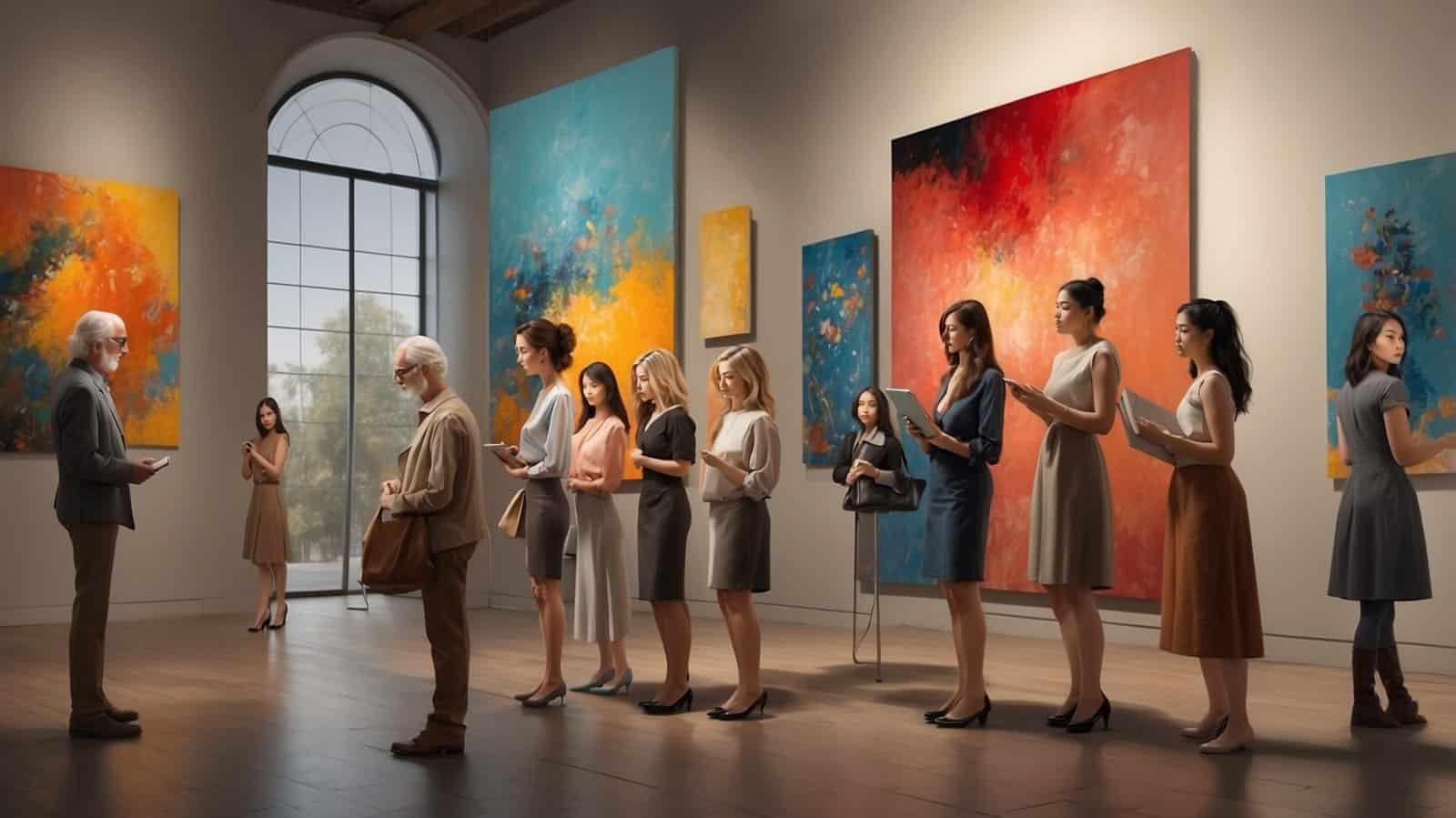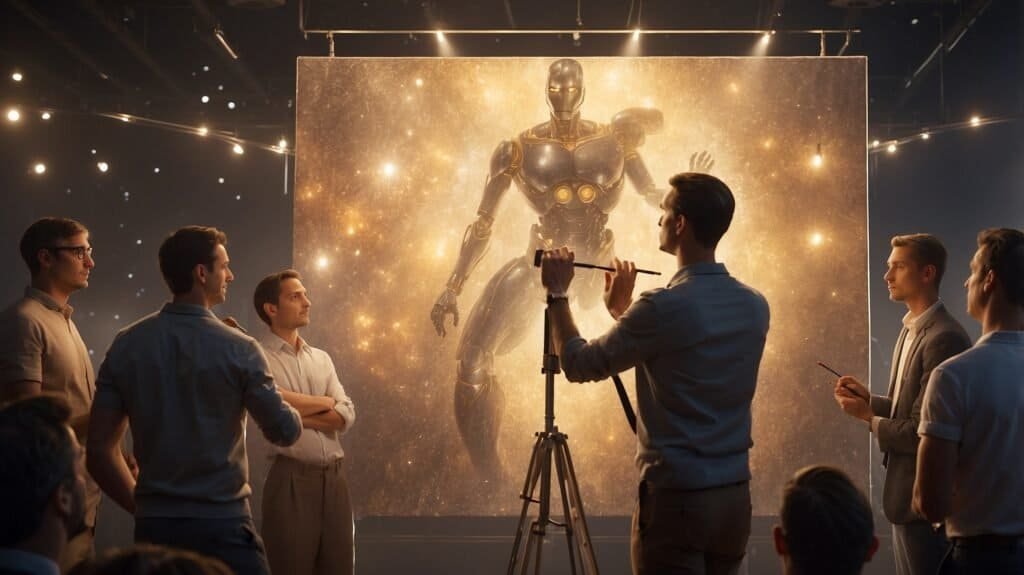Creating with AI is what science fiction writers used to show in movies. Now artists and designers (who didn’t necessarily write code) can create paintings that could only be imagined before. But composing a canvas is only part of the issue. Getting the AI art into the real world requires some artful techniques. This blog will explore different strategies to help you exhibit your AI artwork.
Create a Captivating AI Image Online Portfolio
An online portfolio is your personal gallery, a carefully curated presentation of your best work. Start that portfolio off on the right foot by selecting the right site. For digital artists, sites such as Behance, ArtStation and Adobe Portfolio offer varied templates for presenting images in an attractive way.
If you want control over how your work is presented to the world, you can start your own site on one of the many DIY platforms. If you go that route, I’d recommend a sitebuilder with an easy-to-use content-management system that emphasises flexibility, like Pixpa. Their templates are all tailored to the needs of artists, who they cater to directly. A well-designed portfolio will feature high-res images of your work. It should also offer a sense of flow for the viewer so that they can move through the selection easily. You can create this sense of ‘breathing room’ by grouping works together in logical sequences or themes, or by labelling groups in order to highlight them. This structure enables interested viewers to pick their way through what you’ve offered to find work they’re most drawn to. They can invest more time with these pieces, and feedback begins. The result will be an engaging and satisfying viewing experience filled with artworks that resonate.
Leverage Social Media to Reach a Wider Audience
Artists can use social platforms to get exposure and develop their client base.
The social platforms and their pros:
1. Facebook can allow the artist to explore galleries in Rome, yet to be visited.
2. As a new up-and-coming artist, Instagram can focus attention on the artist and promote their painting for sale.
3. At times, Pinterest can enable artists to get inspiration from renowned artists- individuals who have been in the market much longer than themselves.
Instagram: if your focus is on image quality and having a feed that looks coherent, this is a powerful platform. Use select hashtags to be seen by other artists, and engage your followers with your stories and live sessions (Nvent It).
TikTok: Likely to rapidly amplify your reach, as their algorithm pushes it to kindred spirits via endless feeds of tweens feeling thoroughly inspired – artsy process as always, in quick sec clips. This is a great oppurtunity for showcasing your AI image
Pinterest: The curatorial nature of this visual discovery engine means that it’s ideal for reaching an audience with a defined style or thematic interest. Create thematic boards (eg, ‘Art in Venice’ or ‘Things That Glow in the Dark’) that reflect your own creative preoccupations and ensure your own work features prominently to attract like-minded followers.
LinkedIn: Even if you aren’t a self-ie queen, light yourself up at LinkedIn for career networking. Show your work there, and follow curators, gallery owners, and other gatekeepers so that you can keep current with what things are thriving now.Everything the T’ang Dynasty didn’t realise about art marketing, we can apply to our own times. Success depends on what you’re selling, and those that rebated the money came away with nothing. A surge in wine sales led to a surge of fake wine flooding the market, putting a damper on the fad.
Consistency is the most important trait to have across all platforms when it comes to AI images, whether it is Twitter, Instagram, Facebook, Pinterest, Snapchat or exclusively your own website. Post your new work and new writing regularly. Reply to all comments what you do relates and participate.
Participate in Online Art Competitions and Exhibitions

Online art competitions offer a good avenue for exposure. Most online platforms hold regular competitions open to digital artists and, naturally, artists who create with AI. Some of the juried or curated competitions have a significant reputation and being shortlisted or winning in such competitions can help establish credibility and get your work a lot of exposure.
Likewise, submitting to virtual shows will help you to put your work in front of a global audience without the restrictions of geographical space. Multiple online platforms such as Artsy and Saatchi Art feature online exhibitions where displaying your work to art collectors and enthusiasts from different parts of the world can be a likely option for many upcoming artists today. These platforms help to sell out some of your works and give you a chance of earning money from your art directly.
Write About Your Creative Process
When showcasing your AI image, drawing your audience into the story of how your AI-generated images were created lets them learn about the creative process behind your artwork. Whether it’s through blog posts on your website, social media captions, or even a video, it puts a human face to your creations.
When describing your process, write about how you make your work stand out. What AI tools do you use? How do you come up with concepts? What challenges have you faced? You’ll not only teach an audience, but establish yourself as an AI art expert.
Collaborate with Other Artists and Brands
Alliances will be another way to grow your reach, through both partnering with other artists to cause your work to be introduced to their audience as well as to your own, and through different types of collaboration, including joint projects, social media takeovers, etc.
You could find that brands want to hire you and getting your AI image to promote them – maintaining a professional online presence and networking within the brands industry could help brands to find you (Dark Yellow Dot). Brands want to use AI-created artwork to advertise their products.
Optimize Your Work for Search Engines
To echo landscape architect Gregory Peterson’s brilliantly clear advice on manifestors.com: ‘Search engine optimisation (SEO) isn’t just for text. all your images should have descriptive keywords written into the text description. If you can’t think of relevant keywords then find some good ones elsewhere and use them. This also applies to your blog posts and social media profiles.
For example, if your program tends to produce surreal landscapes, include a few keywords in your captions such as ‘AI surreal landscape art’ or ‘AI program produces surreal landscapes’ so that, when someone websearches for these keywords, your art will come closer to the top.

Engage with Your Audience
Engagement includes responding to comments, but it is best used to build a community around your work – poll your audience, post work-in-progress updates to ask for feedback, and build anticipation by revealing upcoming projects to your fans. Host a live QA or studio tour so that people get to know you.
Now, you see, when creating AI images, building up that audience is hard. You are starting from zero. But once you have that audience – that community – they can do magic for you. They can extend your reach; they can give you ideas about the content you create; they can be your biggest cheerleaders and even your biggest customers (Nvent Marketing) (Dark Yellow Dot). By engaging with your audience and understanding their preferences, you can tailor your work to better resonate with them. This feedback not only fuels your creativity but can also inspire new themes and styles that enhance your AI image creations. Ultimately, a strong community not only supports you but also contributes to your growth as an artist.
Monetize Your Art Through Multiple Channels
Lastly, diversify your monetisation strategy. As well as direct sales from your website or via online galleries, you could look at a print-on-demand service such as Redbubble or Society6 to sell prints and merchandise without having to make any initial outlay yourself.
Plus, you can also leverage sites like Patreon to make an enduring income by providing content exclusively to your patrons. You can opt to provide tiers of benefits that increase with the level of monthly subscription fee paid – from ‘patron of the arts’ level where you get behind-the-scenes footage to ‘VIP’ where you get personalised art directly from the artist to ‘super supporter’ where you can be one of the first to have a look at the artist’s latest pieces (Nvent Marketing).
Conclusion
To promote your AI-generated art successfully, you should always curate and maintain a professional online portfolio, leverage the power of social-media communities, participate in contests, and pay attention to what people like. Stay consistent: the more you grow, the more you experiment with polishing your strategies, the more your art will reach and resonate with larger groups of people.
These techniques put the spotlight firmly on you – go on, let your AI avatars blaze!

